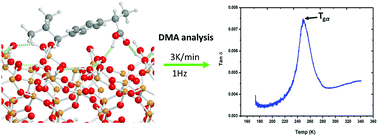Characterising glass transition temperatures and glass dynamics in mesoporous silica-based amorphous drugs†
Abstract
In this study the glass transition temperatures (Tgα and Tgβ) in mesoporous silica-based amorphous drugs were characterized. For this purpose, mesoporous silica Parteck SLC (MPS) was loaded with the drugs ibuprofen and carvedilol, either below, at, or above the monomolecular drug loading capacities, i.e. the concentration at which the entire MPS surface is covered with a monolayer of drug molecules. The resulting amorphous forms were analysed using X-ray powder diffraction and the thermal behaviour was characterised with differential scanning calorimetry (DSC) and dynamic mechanical analysis (DMA). The drug monolayer did not contribute to the thermal signal in DSC. Using DMA however, it could be shown that the monolayer indeed exhibited a very weak Tgα, and that the temperature range of this transition did not differ from that of the quench cooled amorphous drugs. Theoretical ab initio molecular dynamics simulations revealed that the nature of hydrogen bonding geometry of the functional groups interacting with the MPS surface were similar to that of the respective crystalline drugs, which results in restricted molecular motions for those functional groups. On the other hand, the non-interacting parts of the molecules exhibited molecular motions similar to what is observed in pure amorphous drugs. As a result of the interactions of the monolayer with the MPS surface, the monomolecular drug layer did not reveal a Tgβ. However, a Tgβ was found at any drug-MPS ratios above the monomolecular drug loading capacity as a result of the excess drug which forms a “true” amorphous phase. Overall, this study demonstrated that drug molecules forming an amorphous monolayer on the surfaces of a mesoporous silica particle, even though they are restricted in their mobility, exhibit a Tgα, but lack a Tgβ, whereas any excess drug confined in the MPS pores showed similar properties as the pure amorphous drug. These findings will help to increase the overall understanding of drug loaded MS systems, including their physical stability as well as release properties.



 Please wait while we load your content...
Please wait while we load your content...